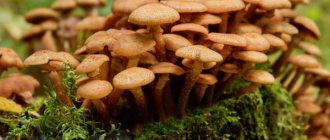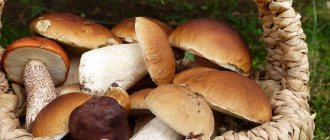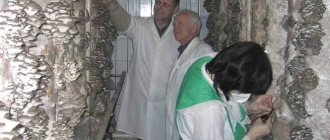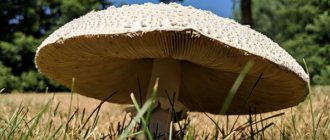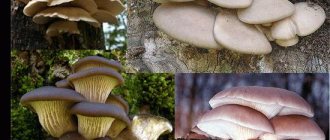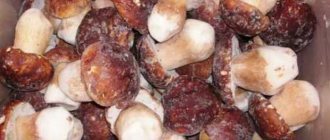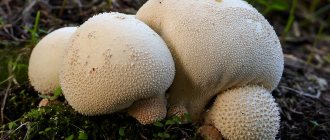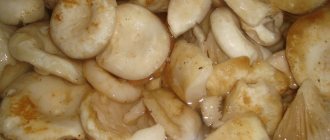Mushrooms
0
1421
Article rating
Kira Stoletova
To save money and get environmentally friendly products, people grow various crops, including mushrooms, in their dachas (using utility rooms for this purpose). They are easy to grow both in the garden and indoors. To effectively organize the growing process, you need to understand what mushroom propagation is and what the specifics of this process are.
Features of mushroom propagation
What is mushroom propagation
Mushrooms represent a separate kingdom of living organisms that are neither plants nor animals. They have their own characteristics, both structure and reproduction, which make them rightfully unique organisms.
The fungal kingdom reproduces in asexual and sexual ways, which can change as they grow.
The asexual method is represented by sporulation (using spores) or vegetative (pieces of mycelium, as well as budding - as in unicellular yeast fungi).
Sexual reproduction of fungi also occurs in different ways. Some fungi have reproductive cells that merge with each other, while in others, reproduction can occur by connecting fungal threads.
Be fruitful and multiply
As it is not difficult to guess, the more methods of reproduction you have, the greater the chances of leaving your offspring on earth. Mushrooms are lucky in this regard - they have access to three types of reproduction at once, within which different methods are also implemented. So it is not surprising that the Kingdom of Mushrooms is so grandiose, and its representatives often demonstrate miracles of survival.
Conditions for the propagation of mushrooms
To grow in open ground, mushrooms require the following conditions:
– shaded place, away from fruit trees;
– substrate in the form of compost, sawdust;
– fresh mycelium;
– air humidity – 75%;
– water without chlorine;
– air with a temperature of +12..+20°С.
To grow indoors, mushrooms require the following conditions:
– room humidity level from 50% to 80%;
– air temperature – + 12…+20°С;
- ventilation;
– carbon dioxide content in the air is not more than 0.15%.
The most important problem when growing mushrooms is maintaining all the optimal conditions.
With the support of microclimatic conditions, growing edible species is possible all year round. In both cases, sterile instruments must be used.
Mushroom propagation methods
Fungi can reproduce in the following ways:
– vegetative;
– asexual;
– sexually;
- budding.
Teleomorphic fungi are able to change their method of reproduction. Asexual and sexual reproduction is characterized by the formation of complex morphological structures that are not similar to each other.
Some species of the fungal kingdom produce at least two types of spores with different functions. This property is called pleomorphism. It is characteristic of oomycots, ascomycots and basidomycots.
The vegetative method is the process of separating some sections of the mycelium (oidia and chlamydospores) from the main mushroom body. It occurs due to the influence of the external environment or the influence of animals. In this case, the new organism is endowed with all the properties of the mother cell. After separation, it becomes the makings of a new mycelium. This method of reproduction proceeds faster than others.
The asexual method of reproduction consists of the formation of hyphae of cells on which sporangia filled with spores develop. They are carried by the wind and are capable of being without living conditions for a long time. And as soon as the disputes get into a favorable environment. Many species, mainly parasites, reproduce in this way.
Budding consists of the formation of daughter organisms from the mother cell. It begins with the division of the nucleus, after which the resulting new organism “bulges out” from the mother cell and turns into a growth.
The sexual process consists of the fusion of female and male reproductive cells.
This is interesting
Scientists are very carefully studying these living organisms. They are not just observed, many experiments are carried out on them. Some of which are shocking. Thus, it is known that Japanese researchers came to the conclusion that yellow yeast is intelligent. They conducted an experiment in which they forced this organism to grow in a “labyrinth” where sugar was hidden. It turned out that the yellow mold “remembers” the path it took to get to the treat. A shoot taken from this organism grew straight to the place where the sugar was! But this is just a simple mushroom that reproduces vegetatively.
Vegetative propagation of mushrooms
The hyphae of many fungi are characterized by a high ability to recover. This property of regeneration underlies the method of vegetative fragmentation. It is actively used in the national economy, for example, when growing champignons or when obtaining hyphae in the laboratory.
The vegetative method is accompanied by the formation of special structures: oidia and chlamydospores. In addition to reproduction, they are able to survive extreme conditions (for example, decreased humidity or sudden changes in temperature). In yeast representatives, reproduction occurs by budding.
Asexual reproduction of fungi
Asexual reproduction occurs through spores. They are unicellular or multicellular structures that are formed during the process of mitosis (cell division). This method of reproduction is characterized by a large number of different functions. Asexual reproduction has several directions. Spores during asexual reproduction can be mobile or immobile (sporangiospores and conidia). Zoospores (mobile spores) are characteristic of primitive fungi whose habitat is water.
The evolution of motile spores is based on the transition of fungi from an aquatic lifestyle to a terrestrial lifestyle. Mucor fungi are characterized by asexual reproduction using endogenous spores that are formed in spherical sporangia.
Many species are characterized by a tendency towards a sharp decrease in the number of spores in sporangia (for example, fungi of the genus “Chonaphora”) and subsequently endogenous sporangiospores are replaced by exogenous conidia (for example, fungi of the genus “Thamnidium”).
In connection with the change from endogenous sporulation to exogenous, this process contributed to the formation of various branched conidiophores and other structures that increase the number of conidia.
The increase in the number of various forms, which leads to the proliferation of exogenous spores, occurs due to the loss of the cycle of the sexual process.
Classification
There is currently no generally accepted classification of fungi, so the information given in the literature or other sources may vary significantly among different authors.
The classification of the fungal kingdom is based primarily on the method of reproduction (see above).
- Zygomycetes (Zygomycota) - haploid syncytium (sometimes with a small number of partitions), in the most primitive ones in the form of a naked lump of protoplasm - an amoeboid or in the form of a single cell with rhizoids, in addition to chitin, there is a lot of pectin in the cell wall, the ability to budding, asexual reproduction by sporangiospores, zygogamy .
- Ascomycetes (Ascomycota) or Marsupial fungi - well-developed multicellular haploid mycelium, the ability to budding and form sclerotia, conidia, gametangiogamy with the formation of bags with ascospores. Ascomycetes are one of the most numerous groups of fungi - more than 32,000 species (~30% of all fungal species known to science). They are distinguished by a huge variety - from microscopic budding forms to mushrooms with very large fruiting bodies.
- Basidiomycetes (Basidiomycota) - multicellular, usually dikaryotic mycelium, can form chlamydospores, somatogamy or autogamy with the formation of basidia with basidiospores. The group includes the vast majority of mushrooms consumed by humans, as well as poisonous mushrooms and many parasites of cultivated and wild plants. In total there are over 30,000 species.
- Deuteromycetes (Deuteromycota) or Imperfect fungi (Anamorphic fungi) - this heterogeneous group includes all fungi with developed mycelium, reproducing by parts of mycelium and conidia and with a hitherto unknown sexual process. There are about 30,000 species.
Asco-, basidio- and deuteromycetes are often combined into the group Higher Fungi (Dikarya).
These groups are united by a cell wall made of chitin, the absence of mobile stages, and more. In addition to them, mushrooms often, especially according to old classifications, include:
- Slime molds (Myxomycota) - (myxomycetes)
- Oomycetes (Oomycota) - well-developed syncytium, the cell wall contains cellulose, asexual reproduction by biflagellate (smooth and pinnate) zoospores and conidia, no sexual sporulation, oogamy, parasites and saprophytes.
- Chytridiomycetes (Chytridiomycota) - haploid multinucleate syncytium (plasmodium), no cell wall, no vegetative reproduction detected, single-flagellate zoospores, no sexual sporulation, gametes are motile, iso- or heterogamy, all representatives are parasites.
Sexual reproduction of fungi
Sexual reproduction is the process of fusion of two nuclei of sex cells (gametes and gametangia) or somatic cells. Mushrooms reproduce in several ways:
- The fusion of gomets is a process called gametogamy (or planogamy). In this case, two cells (gomets) merge. They can both be movable at the same time, and also have different sizes. The mobile ones are called “planogametes”. The process is divided into isogamy (the fusion of two motile gametes of the same size) and heterogamy (the fusion of gametes that differ in size and degree of mobility).
- Formation of oogonia and antheridia - Oogamy. A large egg develops in the oogonia, and sperm are formed in the antheridium. During the process of fusion, sperm enter the egg and the process of fertilization occurs. After the sperm enters the egg, a zygote is formed.
But for some fungi, spermatozoa are not formed during the agamic process. Their eggs are fertilized by the contents of the antheridium, which is not divided into sperm.
- Fusion of gametangia (gametangiogamy), which are not divided into gametes. These structures have a multinuclear structure, and in addition to the fusion of the cytoplasm, the reunification of many nuclei occurs. Zygomycetes fuse with their gametangia, resulting in the formation of a zygospore. After dormancy it germinates into zoosporangium. Female gametangia in ascomycetes are divided into ascogon and trichogyne. The antheridium enters the ascogon through the trichogyne. Male and female nuclei disperse in pairs along the perimeter of the askogon and create dikaryons. As a result, the ascogon shell begins to bulge in places where hyphae with bags at the tops are formed.
- The fusion of somatic or vegetative cells of mycelial hyphae is somatogamy. The process occurs without the formation of reproductive structures. This type of sexual process occurs in chytridiomycotes and hyphochytridymycotes with a unicellular thallus. They merge completely. This process is called “hologamy”.
- The process of gametangiogamy in zygomycetes is called zygogamy. The sexual process has the following stages: heterosexual or unisexual mycelial cells form side branches, or zygophores. These are considered fragments of hyphae. After this, in each process, with the help of the formation of walls, the gametangium is divided. The septum between the gametangia is destroyed and the protoplasts fuse. This is how the nuclei are mixed. The cell that is formed as a result of fusion is covered with a dense wall of several balls and matures into a resting spore, zygospore or zygosporangium. After the ripening process (it takes a very long time - at least 1 month), it goes into a dormant stage and then germinates. At this moment, some of the nuclei fuse, karyogamy occurs and diploid nuclei are formed.
Zygospores, which were formed during the process of sexual reproduction, are similar among representatives of mucoraceae and differ from each other quite insignificantly. The differences lie in the development of the hyphal regions that separate the gametangia. For some, the suspensors are practically invisible, while for others, covering hyphae develop around the zygospores.
After the end of the dormant period, the zygospore begins to germinate, and as a result, only one diploid nucleus survives. It is divided into 4 haploid nuclei, from one new nucleus a sac is formed - a sporangiophorus. All disputes in it are of the same gender.
- Spermatization process. In some fungi, the formation of mononuclear structures is observed, such as conidia on the conidiophore, microconidia capable of copulation, which are generally called spermatia. For many ascomycotas, this role is performed by vegetative hyphal cells, microconidia, condia or spermatozoa, ascospores and budding cells. Marsupial fungi have the property of self-fertilization in ascogones, and apomixis (fusion of the embryo without cell fusion).
The sexual development process in fungi occurs in three stages:
- the first is plasmogamy - the process of fusion of the cytoplasm of two cells that are responsible for sexual reproduction, followed by the transition of the nucleus and cytoplasm into a female or somatic cell.
- the second is karyogamy - a process in which nuclei fuse to form a diploid cell. Lower fungi are characterized by fusion after plasmogamy. For higher animals, this process occurs much later, after the formation of fruiting bodies. For basidiomycetes, the process follows the germination of spores by hyphae of the mycelium. In the next phase, the hyphae of basidiomycetes become dikaryotic.
- the third - meiosis - cell division, occurs after karyogamy. This is followed by mitotic division. As a result, the number of spores is always even or a multiple of 4. Usually it is from 8 to 32 units.
Prevalence
In animals
In arthropods
Tardigrades, aphids, balanuses, several species of cockroaches, some ants and many other social insects have the ability for parthenogenesis among arthropods.
Small crustaceans have the ability to parthenogenesis. Daphnia, for example, reproduce by ameiotic parthenogenesis. Under favorable conditions, only females appear in daphnia. If conditions begin to change (drying out of the reservoir), males hatch from the same eggs and fertilize the females. Females lay eggs. Fertilized eggs rest at the bottom of the reservoir and are able to withstand the drying out of the reservoir.
Ants
In ants, thelytoky parthenogenesis is found in 8 species and can be divided into 3 main types: type A - females produce females and workers through thelytoky, but the workers are sterile and there are no males (Mycocepurus smithii); type B - workers produce workers and potential females through thelytoky; type C - females produce females thelytokically and workers produce females through normal sexual intercourse, while workers produce females via thelytoky. Males are known for types B and C. Type B found in Cerapachys biroi
, two myrmicine species,
Messor capitatus
and
Pristomyrmex punctatus
, and the ponerine species
Platythyrea punctata
.
Type C is found in the running ant Cataglyphis cursor
and the two myrmicine species
Wasmannia auropunctata
and
Vollenhovia emeryi
.
Termites
Asexual reproduction in the form of thelytokic parthenogenesis has been found in 7 species of termites, including: Reticulitermes speratus
,
Zootermopsis angusticollis
,
Kalotermes flavicollis
,
Bifiditermes beesoni
.
In vertebrates
Parthenogenesis is rare in vertebrates and occurs in approximately 70 species, representing 0.1% of all vertebrates. For example, there are several species of lizards that naturally reproduce by parthenogenesis (rock lizards, Komodo dragons). Parthenogenetic populations are also found in some species of fish, amphibians, and birds (including chickens). Among mammals, cases of parthenogenesis are not yet known.
Parthenogenesis in Komodo dragons is possible because oogenesis is accompanied by the development of a polocyte (polar body) containing a double copy of the DNA of the egg; The polococyte does not die and acts as sperm, turning the egg into an embryo.
A similar process in plants is called. It can be vegetative propagation, or propagation by seeds produced without fertilization: either as a result of a type of meiosis that does not halve the number of chromosomes, or from diploid cells of the ovule. Since many plants have a special mechanism: double fertilization, in some of them (for example, in several types of cinquefoil) pseudogamy is possible - when the seeds are obtained with an embryo developing from an unfertilized egg, but contain triploid endosperm resulting from pollination and subsequent triple fusion.
Reproduction of mold fungi
Molds reproduce through cell division. In this case, the bacterium breaks down into two parts. They may not always be the same. One of them is considered the mother, and the second is the daughter. The first is characterized by division 10-17 times, after which it dissolves. Some bacteria are characterized by budding.
Bacteria multiply at a rapid pace: no more than half an hour passes between divisions. With such activity, new cells of one bacterium can fill the basins of all oceans and seas in just a few days. But they cannot overcome harsh climatic conditions and the influence of other organisms.
During the formation of spores, the contents inside the cell become denser and a dense shell appears on its surface, where compounds of a waxy consistency accumulate. This determines the main role of bacterial spores. They serve not for reproduction, but to protect cells from unfavorable conditions.
Sporulation is characteristic only of bacilli. They are formed inside cells, and their shape and size can change or remain unchanged.
When spores enter a favorable environment, they germinate. The membrane ruptures and a bacterial cell grows through it.
Bacillus spores are characterized by high resistance to very low and very high temperatures. As an example, Bacillus subtilis can die only after 3 hours of sterilization.
Expired plaster. Consequences?
The quality won't be the same. It may not turn out to be a homogeneous mass, but stick together into lumps. You can, for example, mix 1 to 1 or 2 to 1 with new plaster. In general, it’s better to call a good plasterer to the place so that he can feel the composition and give his opinion.
2 months of delay is a short period. It may not have any effect at all! You have to try it - how it is mixed, how it is applied, how it hardens. The main problem is the formation of unstirable lumps, or weak setting after hardening. Let an experienced plasterer apply 1 test bag and let it dry. Everything will become clear.
Find contacts and a phone number on the bag, call the technologist and explain everything, how the mixture was stored, what condition it was in and what to do with it.
If the material was not initially purchased cheaply, and not from a felting shop, but from a company with a name and “handwriting” - that is, stored in a safe (protected and possibly heated) warehouse - then this may mean that the material is not counterfeit. And accordingly, if it is not scattered by the Uzbeks in the “nearest gateway”, then what will happen to this crumble!?
- it is without moisture and frost - it can be stored for at least 100 years. And cracks and peelings can arise from unskilled hands of performers - they did not remove dust, the surface was not primed according to the technology, water was again splashed more or less. And there is only one excuse: - It’s your customer’s fault, your material is bad))).
Lyaksey. Well, you are wonderful, dear friend. It is clear that when people started talking about hundred, it was slang. It is clear that a good performer, before making a bet, will try the material, so to speak, “to the teeth.” And a particularly stingy customer will find a “cure” for himself in the person of a leftist performer. Well, let them “play” - the main thing is that you and I have a head on our shoulders, not just to wear a hat).
The material is not suitable for work, the quality is zero.
try it at work. There is a chance that everything is in order. There have been longer delays.
Daria, as I understand it, is it Rotband or an analogue on a gypsum base? The delay is small, but the consequences may well be sad. It may well take longer to dry after application, especially with a layer of more than 2 cm. It may not set at all. That is. even after 3 days it will be loose and damp. No matter how qualified craftsmen work for you, they will not be able to do anything in this case.
Similar issues are regularly discussed on the forum and as a result, people end up having to completely redo the plaster. The optimism of the participants above is a good thing, but take my word for it that any of the above will not undertake to work with a delay, or will ask you for a receipt confirming the refusal of the guarantee. The most reasonable The solution is to sell the existing plaster at a cheap price to hacks and buy a new one. And for the future, never buy such things in advance, even if you can get it at a cheap price (at a promotion or to beat inflation).
I worked with expired gypsum plaster, the result: it set quickly, it lasted for 10 minutes and froze. I used it as alabaster.
What kind of plaster? Cement or gypsum?
the main thing is that the bags are intact and the mixture itself is not pebbles or stones and add primer with water 1-1
Reproduction of microscopic fungi
Microscopic fungi are characterized by asexual and sexual reproduction.
Vegetative propagation occurs with the help of pieces of mycelium and aerial hyphae or by sporulation. In such cases, spores form and germinate inside sporangia (or endospores), as well as outside on conidiophores (conidia or exospores).
During sexual reproduction, microscopic fungal cells fuse in pairs. The process can proceed in different ways. In some cases, a cell with a dense membrane and a zygote is formed. After a while, it germinates and a new mycelium is formed.
Other fungi are characterized by the formation of a multicellular fruiting body. It develops sacs where spores develop. When ripe, the sac ruptures, and the spores disperse in different directions and new mycelium grows from them. There are also a number of basidomycete fungi, spores develop in processes, basidia.
Protection Mechanisms
The mycelium of forest mushrooms can exist for many years, and therefore it must be able to adapt to such unfavorable environmental conditions as drought or severe frosts. This task is performed by special protective mechanisms that allow the mycelium to enter a dormant stage, a kind of hibernation.
There are two main types of dormant mycelium. One of them is rhizomorphs
, which are branched brown or almost black cord-like bodies, reaching a length of several meters. They consist of a shell and a core. The dense shell is formed by dead cells and acts as a protective tissue. The core contains white or almost colorless living hyphae, as well as fat that provides nutrition to the mycelium.
While in the soil, rhizomorphs intertwine with the roots of trees, and then penetrate under the bark and fill the space under it, climbing the trunk. When favorable conditions occur, thin hyphae appear at the tips of the cord-like bodies, which subsequently grow, signaling that the time has come for a new active life. The formation of rhizomorphs is characteristic to a greater extent for fungi leading a parasitic lifestyle; they have been especially well studied in autumn honey mushrooms (Armillaria mellea).
Another type of resting mycelium is sclerotium
. Externally, it looks like an oblong or round body with an uneven surface. The length and thickness of the sclerotium can vary significantly among different mushrooms; usually these parameters vary from a few millimeters to several tens of centimeters. Sclerotium, like rhizomorphs, has a dense protective shell and core in which hyphae and the necessary substances for their nutrition (mostly fats) are located.
Sclerotia of basidiomycetes and ascomycetes can develop in the soil, on the roots and branches of trees. When favorable conditions occur, the fruiting body of the fungus begins to grow from it, and at the same time the sclerotium itself begins to partially or completely decompose, transferring its contents to the fruiting body. It is noteworthy that the hyphae located in the sclerotia contain a minimal amount of water, but do not lose their ability to germinate even after years of hibernation.
Reproduction of yeast fungi
Yeasts reproduce either vegetatively or sexually. Vegetative reproduction is based on budding and division, and sexual reproduction is based on the formation of spores.
There are the following methods for vegetative propagation of yeast:
1. Multilateral budding is formed at different places on the cell surface.
2. Biopolar - budding occurs from each pole of the cell in strict order.
3. Binary division - the mother cell becomes oblong, its nucleus divides, after which new ones move to different poles of the cell in turn.
Budding is the period during which a cell can form its own kind. The cycle consists of four phases: presynthetic, synthetic, postsynthetic, mitosis and cytokinesis. Cell division occurs similar to bacterial division.
Notes
- Grasso D. A. T., Wenseleers T., Mori A., Le Moli F., Billen J. (2000). Thelytokous worker reproduction and lack of Wolbachia infection in the harvesting ant Messor capitatus. Ethology, Ecology and Evolution 12: 309–314.
- Tsuji K. (1988). Obligate parthenogenesis and reproductive division of labor in the Japanese queenless ant Pristomyrmex pungens. Behavior, Ecology and Sociobiology 23: 247–255.
- Dobata S., Sasaki T., Mori H., Hasegawa E., Shimada M., Tsuji K. (2009). Cheater genotypes in the parthenogenetic ant Pristomyrmex punctatus. Proceedings of the Royal Society London Series B 276: 567–74.
- Heinze J, Hölldobler B. (1995). Thelytokous parthenogenesis and dominance hierarchies in the ponerine ant, Platythyrea punctata. Naturwissenschaften 82: 40–41.
- Cagniant H. (1979). La parthénogénese thélytoque et arrhénotoque chez la fourmi Cataglyphis cursor Fonsc. (Hym. Form.). Cycle biologique en élevage des colonies avec reine et des colonies sans reine. Insectes Sociaux 26:51–60.
- Fournier D., Estoup A., Orivel J., Foucaud J., Jourdan H., et al. (2005). Clonal reproduction by males and females in the little fire ant. Nature 435:1230–1234.
- Ohkawara K., Nakayama M., Satoh A., Trindl A., Heinze J. (2006). Clonal reproduction and genetic differences in a queen polymorphic ant Vollenhovia emeryi. Biological Letters 2: 359–363.
Propagation of porcini mushrooms
The process of reproduction of porcini mushrooms occurs with the help of spores that develop under the cap. They are difficult to see, since their size is no more than 200 microns. Under a microscope it is noticeable that they have different shapes. After maturation, the spores are scattered over vast distances with the help of wind and rain.
In favorable soil they germinate quickly. First, they sprout threads that resemble mold. They begin to intertwine and grow actively. Hyphae penetrate the forest floor and soil. To develop, they need to receive a stable flow of air. With sufficient moisture and the presence of minerals, the mycelium will consistently bear fruit.
Reproduction of lower fungi
In many lower fungi, asexual reproduction occurs with the help of zoospores, which move using flagella. Zoospores develop in zoosporangia.
Lower fungi are characterized by a vegetative body, which is formed from mycelium with a cellular structure with an imperfect sexual method. Their mycelium does not have partitions with many branches.
Lower fungi are divided into three main classes:
- Oomycetes - have a developed mycelium with an oogamous sexual process.
- Chytridomycetes are the simplest microorganisms that live in the aquatic environment. They typically reproduce sexually and vegetatively.
- Zygomycetes are the most common lower microorganisms living on land. They reproduce by a special sexual method - zygogamy.
Continuation of life
Every living organism living on earth has two main natural functions - to steadily maintain its own vital activity, by searching for the necessary living conditions and nutrients, and to give offspring, continuing the existence of its genetic code in this world.
These tasks also face mushrooms, which cope with them perfectly, being able, in search of food, to spread their mycelium hundreds of meters underground, and using many very successful and inventive methods of reproduction.
